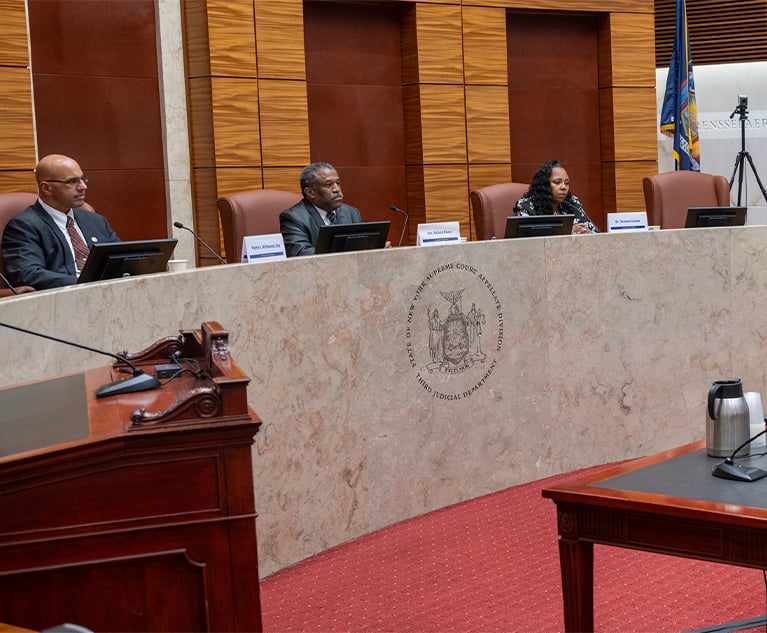Court System Officials Want To See More ADR in New York
New York state court system officials are pushing forward with an effort to increase the use of alternative dispute resolution in the courts, which they say is an underused method of helping to move cases more quickly through the pipeline.
April 27, 2018 at 05:57 PM
3 minute read
 Photo Credit: Shutterstock
Photo Credit: Shutterstock New York state court system officials are pushing forward with an effort to increase the use of alternative dispute resolution in the courts, which they say is an underused method of helping to move cases more quickly through the pipeline.
Office of Court Administration officials said that employing arbitration, mediation, neutral evaluation and collaborative law to handle certain cases could save courts and litigants money that they would have spent on pricey litigation, as well as clear up court backlogs, which has been a top priority for Chief Judge Janet DiFiore since taking the reins of the state judiciary in 2016.
In a news release, Chief Administrative Judge Lawrence Marks said that the court system would focus its efforts to expand ADR on the state Supreme Court, lower civil courts, Family Courts and Surrogates Courts.
To guide the statewide effort to increase the use of ADR, court officials have convened a blue ribbon advisory committee of lawyers, judges and academics to study the ADR programs already in place in both state and federal courts in New York, as well as those in other states, and look for places where ADR can be extended.
John Kiernan, a partner at Debevoise & Plimpton who is wrapping up his tenure as president of the New York City Bar Association, has been named head of the commission. He said that some courts have already developed working models for diverting some cases to ADR—for example, in Manhattan Supreme Court's Commercial Division, contract disputes that are matters of $500,000 or less are diverted into mandatory mediation.
In another example, Manhattan Supreme Court offers a matrimonial mediation program that offers mediation services for divorces that don't involve allegations of child abuse and neglect.
“I don't think any part of the aim of the committee is to fix something that is broken,” Kiernan said. He said that the advisory committee's first task will likely involve taking an inventory of all ADR services currently in New York.
As it stands now, litigants are referred to ADR programs by the judges handling their cases, and ADR services are provided by either court staff or mediators. The use of ADR in state courts has grown, officials said, but not enough.
The Appellate Division, Second Department—one of the busiest intermediate appellate courts in the country—has one of the country's oldest settlement programs. In 1974, it established the Civil Appeals Management Program (CAMP), in which an administrator pores over cases on appeal to determine if they could be resolved by settlement rather than litigation.
Randall Eng, the recently retired presiding justice of the Second Department who is now of counsel to Meyer, Suozzi, English & Klein, said that during his time with the state court system, roughly 60 percent of the qualifying cases referred to CAMP reached a settlement.
Diverting some cases to ADR can not only save money on cases, Eng said, but can save litigants from “unexpected, undesirable” outcomes that can potentially arise from settling matters through litigation or jury trials.
“ADR is valuable, there's no question about it,” Eng said. “Litigation is very expensive.”
This content has been archived. It is available through our partners, LexisNexis® and Bloomberg Law.
To view this content, please continue to their sites.
Not a Lexis Subscriber?
Subscribe Now
Not a Bloomberg Law Subscriber?
Subscribe Now
NOT FOR REPRINT
© 2025 ALM Global, LLC, All Rights Reserved. Request academic re-use from www.copyright.com. All other uses, submit a request to [email protected]. For more information visit Asset & Logo Licensing.
You Might Like
View All

Law Firms Expand Scope of Immigration Expertise Amid Blitz of Trump Orders
6 minute read
'Reluctant to Trust'?: NY Courts Continue to Grapple With Complexities of Jury Diversity
Trending Stories
- 1Uber Files RICO Suit Against Plaintiff-Side Firms Alleging Fraudulent Injury Claims
- 2The Law Firm Disrupted: Scrutinizing the Elephant More Than the Mouse
- 3Inherent Diminished Value Damages Unavailable to 3rd-Party Claimants, Court Says
- 4Pa. Defense Firm Sued by Client Over Ex-Eagles Player's $43.5M Med Mal Win
- 5Losses Mount at Morris Manning, but Departing Ex-Chair Stays Bullish About His Old Firm's Future
Who Got The Work
J. Brugh Lower of Gibbons has entered an appearance for industrial equipment supplier Devco Corporation in a pending trademark infringement lawsuit. The suit, accusing the defendant of selling knock-off Graco products, was filed Dec. 18 in New Jersey District Court by Rivkin Radler on behalf of Graco Inc. and Graco Minnesota. The case, assigned to U.S. District Judge Zahid N. Quraishi, is 3:24-cv-11294, Graco Inc. et al v. Devco Corporation.
Who Got The Work
Rebecca Maller-Stein and Kent A. Yalowitz of Arnold & Porter Kaye Scholer have entered their appearances for Hanaco Venture Capital and its executives, Lior Prosor and David Frankel, in a pending securities lawsuit. The action, filed on Dec. 24 in New York Southern District Court by Zell, Aron & Co. on behalf of Goldeneye Advisors, accuses the defendants of negligently and fraudulently managing the plaintiff's $1 million investment. The case, assigned to U.S. District Judge Vernon S. Broderick, is 1:24-cv-09918, Goldeneye Advisors, LLC v. Hanaco Venture Capital, Ltd. et al.
Who Got The Work
Attorneys from A&O Shearman has stepped in as defense counsel for Toronto-Dominion Bank and other defendants in a pending securities class action. The suit, filed Dec. 11 in New York Southern District Court by Bleichmar Fonti & Auld, accuses the defendants of concealing the bank's 'pervasive' deficiencies in regards to its compliance with the Bank Secrecy Act and the quality of its anti-money laundering controls. The case, assigned to U.S. District Judge Arun Subramanian, is 1:24-cv-09445, Gonzalez v. The Toronto-Dominion Bank et al.
Who Got The Work
Crown Castle International, a Pennsylvania company providing shared communications infrastructure, has turned to Luke D. Wolf of Gordon Rees Scully Mansukhani to fend off a pending breach-of-contract lawsuit. The court action, filed Nov. 25 in Michigan Eastern District Court by Hooper Hathaway PC on behalf of The Town Residences LLC, accuses Crown Castle of failing to transfer approximately $30,000 in utility payments from T-Mobile in breach of a roof-top lease and assignment agreement. The case, assigned to U.S. District Judge Susan K. Declercq, is 2:24-cv-13131, The Town Residences LLC v. T-Mobile US, Inc. et al.
Who Got The Work
Wilfred P. Coronato and Daniel M. Schwartz of McCarter & English have stepped in as defense counsel to Electrolux Home Products Inc. in a pending product liability lawsuit. The court action, filed Nov. 26 in New York Eastern District Court by Poulos Lopiccolo PC and Nagel Rice LLP on behalf of David Stern, alleges that the defendant's refrigerators’ drawers and shelving repeatedly break and fall apart within months after purchase. The case, assigned to U.S. District Judge Joan M. Azrack, is 2:24-cv-08204, Stern v. Electrolux Home Products, Inc.
Featured Firms
Law Offices of Gary Martin Hays & Associates, P.C.
(470) 294-1674
Law Offices of Mark E. Salomone
(857) 444-6468
Smith & Hassler
(713) 739-1250







